
Obdurodon is an extinct monotreme genus containing three species. Individuals of Obdurodon differed from modern platypuses in that adult individuals retained their molar teeth. Compared to the modern platypus, which is a mostly benthic forager, Obdurodon foraged pelagically.
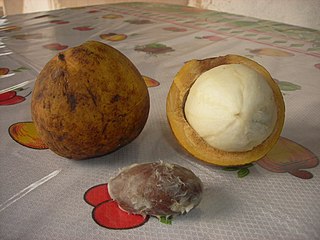
Platonia insignis, the sole species of the genus Platonia, is a tree of the family Clusiaceae native to South America in the humid forests of Brazil, Paraguay, parts of Colombia and northeast to Guyana; specially in Amazon Rainforest. Common names include bacuri, maniballi, naranjillo and bacurizeiro.
South Button Island National Park is a national park located in the Andaman and Nicobar Islands off the coast of India, the total area of this protected island is about 5 km2 (2 sq mi). Along with the neighbouring islands of North Button and Middle Button, both also national parks, it forms part of the Rani Jhansi Marine National Park off the coast of South Andaman Island.
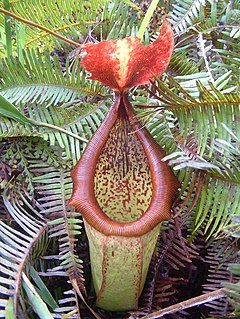
Nepenthes insignis is a tropical pitcher plant endemic to New Guinea and surrounding islands. The specific epithet insignis is Latin for "distinguished" or "remarkable".

The black house spider or common black spider is a common species of cribellate Australian spider, introduced to New Zealand and Japan. A closely related species, Badumna longinqua, the grey house spider, has a similar distribution, but has also been introduced to the Americas.

Brighamia insignis, commonly known as ʻŌlulu or Alula in Hawaiian, or colloquially as the vulcan palm or cabbage on a stick, is a critically endangered species of Hawaiian lobelioid in the bellflower family, Campanulaceae. It is native to the islands of Kauaʻi and Niʻihau. This short-lived perennial species is a member of a unique endemic Hawaiian genus with only one other species.
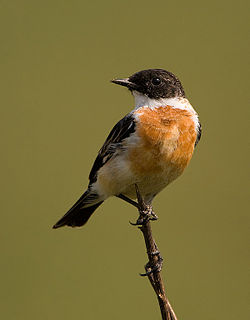
The white-throated bush chat, also known as Hodgson's bushchat, is an Old World flycatcher in the genus Saxicola. It is IUCN Red Listed as Vulnerable by BirdLife International. In 2001, the global population has been estimated at between 3,500 and 15,000 individuals. The major threat appears to be the rapid loss of grasslands in its wintering areas. It winters in the Nepal and Indian Terai and in the Dooars. In this region, it has been recorded in Jim Corbett, Shuklaphanta, Chitwan, Kaziranga, and Manas National Parks and in Lumbini Crane Sanctuary. It prefers wet and dry grasslands, reeds and tamarisks along riverbeds, and also occurs in sugarcane fields. In spring and summer, it breeds in the alpine or sub-alpine meadows and scrub in the mountains of Mongolia and adjacent parts of Russia.
The Mindanao montane forest mouse is a species of rodent in the family Muridae. It is found only in the Philippines.
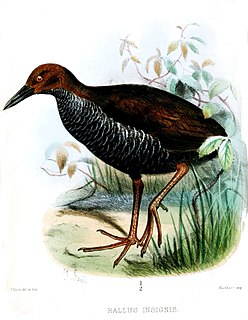
The pink-legged rail, also known as the New Britain rail, is a species of bird in the family Rallidae.

The brown-capped weaver is a species of bird in the family Ploceidae. It is found in Angola, Burundi, Cameroon, Republic of the Congo, Democratic Republic of the Congo, Equatorial Guinea, Kenya, Nigeria, Rwanda, South Sudan, Tanzania, and Uganda.

Cassin's honeybird, also known as Cassin's honeyguide, is a species of bird in the family Indicatoridae.

The Cameroon scaly-tail, also referred to as the Cameroon anomalure, flightless anomalure, or flightless scaly-tail, is a rodent species endemic to West Central Africa. The scientific literature has never reported observations of live individuals. The taxonomic classification of the species has been subject to recent revision.
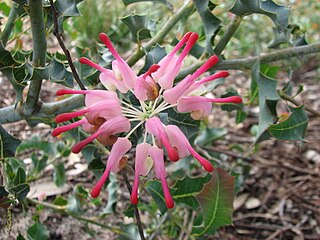
Grevillea insignis, commonly known as wax grevillea, is a shrub species which is endemic to the south-west of Western Australia. The species was first formally described in 1855 in Hooker's Journal of Botany and Kew Garden Miscellany.
Metarctia insignis is a moth of the subfamily Arctiinae. It was described by Sergius G. Kiriakoff in 1959. It is found in Rwanda and Tanzania.
Ooperipatellus insignis is a species of velvet worm in the Peripatopsidae family. It is found in Victoria, Australia.
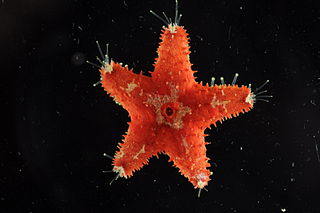
Euretaster insignis, commonly known as the striking sea star, is a species of starfish in the family Pterasteridae found in the central west Pacific Ocean. It is one of only three species in the order Velatida to be found in shallow water in the tropics. The young are brooded in a cavity underneath a "supradorsal" membrane.

Comptosia is a genus of bee flies. There are at least 62 described species including the common Australian insects Comptosia apicalis, Comptosia neobiguttata and Comptosia insignis.
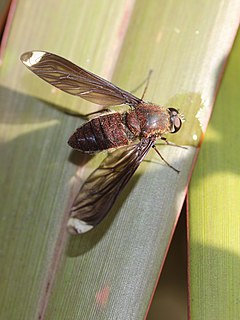
Comptosia apicalis is a species of bee flies in the family Bombyliidae.

Comptosia quadripennis is a species of bee flies in the family Bombyliidae.

Comptosia neobiguttata is a species of bee flies in the family Bombyliidae.















